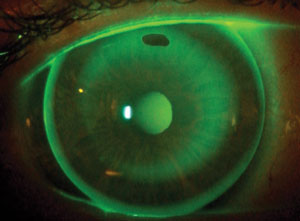 |
|
Ocular side effects of ortho-K wear tend to resolve within a year. Photo: Daddi Fadel, DOptom. Click image to enlarge. |
A recent study exploring factors associated with ocular discomfort and ocular surface changes in orthokeratology (ortho-K) found that lens wear increased symptoms of discomfort and decreased functionality of the tear film, mostly within three months of use. While tear-related visual function parameters were correlated with ocular discomfort, baseline levels were reached again after 12 months.
In 50 patients assigned to ortho-K wear, clinical evaluation of the ocular surface included the ocular surface disease index (OSDI), slit lamp examination, Keratograph 5M, optical quality analysis and corneal staining. The same experienced operator conducted all measurements throughout the study, two to four hours after lens removal. Participants were required to wear the lenses for at least eight hours per night for six days a week.
Overall, OSDI score and two subscale scores (ocular symptoms and vision-related function) significantly increased at the three-month visit and decreased to levels close to baseline at the 12-month visit. The basic objective scatter index and the mean tear film objective scatter index also followed the same trajectory, peaking at the three-month visit and gradually decreasing thereafter. After one week of lens wear, grade one corneal staining increased to 16.4%, mostly involving the central and inferior cornea. During the 12-month study period, the overall OSDI score and vision-related function score were significantly and positively correlated with the basic objective scatter index and mean tear film objective scatter index.
A new parameter that the researchers measured with the optical quality analysis system, the tear film objective scatter index, was more sensitive in detecting the quality and stability of the tear film than traditional indicators. The parameter was obtained by subtracting the basic objective scatter index from the total objective scatter index. The researchers believe that the optical quality analysis system may be useful in tear film assessments and long-term follow-up of patients treated with ortho-K lenses.
“A more precise assessment of optical quality alterations and their impact on vision quality is important in patients undergoing ortho-K lens wear,” they noted in their paper.
Xie C, Wei R. Long-term changes in the ocular surface during orthokeratology lens wear and their correlations with ocular discomfort symptoms. Cont Lens Anterior Eye. September 20, 2022. [Epub ahead of print]. |


